Abstract: This study focuses on the open-end damping ring of high-speed spiral bevel gears. Based on the unit load method and Hertz contact theory, the contact pressure and stiffness between the C-type damping ring and the spoke plate are calculated. An equivalent finite element model is established in ABAQUS to conduct explicit dynamic analysis, investigating the effects of damping ring width, thickness, and opening amount on gear vibration characteristics. The results provide guidance for selecting structural parameters of damping rings.

Keywords: spiral bevel gear; C-type damping ring; explicit dynamics; dynamic response
1. Introduction
Vibration and impact generated by high-speed gear operation are the sources of mechanical system vibration and noise. Excessive dynamic load acceleration can lead to early failure of transmission components. Therefore, it is necessary to adopt vibration reduction measures for high-speed transmission gears. Damping rings, due to their low mass, simple structure, minimal impact on gear structure, and strong robustness, are highly suitable for high-speed aviation gears.
2. Mathematical Model
2.1 Contact Pressure Solution of Damping Ring
The structure of the C-type damping ring. Due to the elastic tension of the C-type damping ring, it fits tightly with the installation groove, and the centrifugal force during high-speed rotation enhances this fit.
The contact pressure q is calculated using the unit load method and is given by:
q=function of R,E,G,J,Ky,A,ρ,ω,and Δ
Where R is the radius, E and G are the elastic and shear moduli, J is the inertia moment of the cross-sectional area, Ky is the cross-sectional shape coefficient, A is the cross-sectional area, ρ is the density, ω is the angular velocity, and Δ is the opening amount.
2.2 Contact Stiffness Calculation
According to Hertz contact theory, the relationship between normal deformation Δz and normal force p is:
Δz=E∗8Rp(E11−μ12+E21−μ22)−1
Where E∗ is the equivalent elastic modulus, and μ1 and μ2 are the Poisson’s ratios of the two materials in contact.
The normal contact stiffness Kn is given by:
Kn=dΔzdp
3. Influence of Damping Ring Structural Parameters on Gear Vibration
3.1 Gear Basic Parameters and 3D Model
The study focuses on a spiral bevel gear pair with a working speed of 20 kr/min and a power of 1.5 kW. Table 1 lists the basic geometric parameters of the gear pair.
3.2 Finite Element Model and Analysis Settings
The finite element mesh model, with damping ring installation indicated.
Finite element mesh model
Sketch of damping ring installation position
The analysis settings include:
- Material properties: 20CrMnTi with an elastic modulus of 2.07×10^11 Pa, a density of 7.8×10^3 kg/m^3, and a Poisson’s ratio of 0.25.
- Rigid body coupling reference points set at the gear centroids.
- Smooth application of torque and speed over specific time intervals.
- Contacts and friction set between gear teeth and damping ring-groove interfaces.
3.3 Results and Discussion
The contact stiffness of damping rings with different structural parameters.
Summarizes the fluctuation in gear vibration due to changes in damping ring structural variables.
Fluctuation of influence of damping ring structure variables on gear vibration
The results indicate that:
- As damping ring width and opening amount increase, gear vibration acceleration first decreases and then increases.
- As damping ring thickness increases, gear vibration acceleration first decreases, then increases, and then decreases again, with optimal damping at 3 mm thickness.
- Damping ring width has the greatest impact on gear vibration.
4. Dynamic Characteristic Analysis
Based on the optimal parameters (width b = 5 mm, thickness h = 3 mm, opening amount Δ = 15 mm), the damping effect is verified. The normal contact stiffness Kn = 817,275.635 N/mm and tangential stiffness Kt = 612,956.726 N/mm.
Table 4 lists the root mean square (RMS) values of vibration acceleration in different directions for reference points with and without a damping ring.
<img src=”https://example.com/vibration_acceleration_table.png” />
Table 4: RMS values of vibration acceleration
The axial time-domain vibration acceleration curves.
Axial time-domain vibration acceleration curves
The Fourier transform of the time-domain vibration curves.
The results show that the damping ring significantly reduces vibration, with the most notable effect in the axial direction. The axial vibration at reference point 1 is reduced by 54.58%, and the axial vibration at reference point 2 is reduced by 45.48%.
5. Conclusion
This study investigated the influence of structural parameters of open-end damping rings on the dynamic response characteristics of high-speed spiral bevel gears. The results indicate that the C-type damping ring has the most significant vibration reduction effect on the axial direction. The optimal damping effect is achieved with specific combinations of width, thickness, and opening amount. These findings provide guidance for the selection of structural parameters of damping rings in high-speed gear applications.
